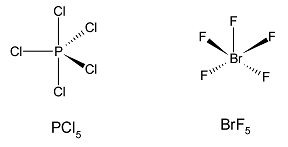Question
Question: Using VSEPR theory, draw the shape of \(PC{l_5}\)and \(Br{F_5}\)...
Using VSEPR theory, draw the shape of PCl5and BrF5
Solution
To answer this question, we must find the hybridisation of the central atom and the arrangement of the bond pairs and lone pairs on the central atom. To do that, you must recall the VSEPR (Valence shell electron pair repulsion) theory. It proposes that all valence shell electrons surrounding the central atom arrange themselves in such a manner so as to be as far away from each other as possible to avoid repulsion between the electron pairs.
Complete step by step solution:
Considering PCl5.
The atomic number of phosphorus is 15. It also has an empty 3d orbital and can thus use all the five electrons present for bonding. The ground state electron configuration for phosphorus is:
P:[Ne]3s23p33d0
One electron is excited to the 3dorbital. The excited state configuration becomes:
P:[Ne]3s13p33d1
Phosphorus undergoes an sp3d hybridization. Now it has five hybrid orbitals available for bonding and no extra electrons. According to the VSEPR theory, three bonds are placed in an equatorial form and two remaining bonds are present axially perpendicular to the equatorial bonds. The shape of PCl5is trigonal bipyramidal.
Considering BrF5
Bromine is a group 17 element or a halogen. It has 7 valence electrons. It also has empty d orbital and can increase its covalency to form five bonds. Two electrons from its valence p orbital are excited to the d orbital and the bromine atom undergoes a hybridisation of sp3d2. There are six electron pairs around the central bromine atom, out of which five are bond pairs and one is lone pair. According to VSEPR theory, the geometry of the molecule is octahedral but the shape is square pyramidal.

Note:
The atomic orbitals of an atom are mixed in order to produce equivalent orbitals during bond formation. This mixing of orbitals is known as hybridisation. The arrangement of these hybrid orbitals according to the VSEPR theory gives us the shape of the molecule.
